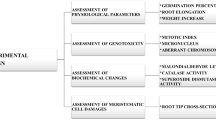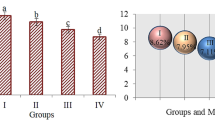Abstract
THE best insecticides and fungicides will be those which kill the plant parasites without affecting the plant organism. In fact, they all affect the host plant more or less in various ways and degrees1–4. A series of fungicides and insecticides may have very similar effects on the plant organisms. Ethyl-mercury-chloride (CH3CH2HgCl), which is the active substance (2 per cent) of the fungicide ‘Granosan', induces atypical growth, abnormal mitosis and polyploidy3,4, reminding one of the effect of colchicine and acenaphthene5,6. A similar and very strong effect of this kind is produced by hexachlorocyclo—hexane—another chlor-organic compound—which is the active substance of a series of very effective insecticides, recently recommended under various names. The insecticides ‘Agrocides' (7, 3, etc.), for example, the active substance of which is the gamma isomer of 1,2,3,4,5,6-hexachlorocyclohexane (‘Gammexane'), induce atypical growth, suppressing the development of the roots, stems and coleoptyles of gramineous plants, producing very striking thickening of these organs, especially of the growing points (root tips and coleoptyles).
This is a preview of subscription content, access via your institution
Access options
Subscribe to this journal
Receive 51 print issues and online access
$199.00 per year
only $3.90 per issue
Buy this article
- Purchase on Springer Link
- Instant access to full article PDF
Prices may be subject to local taxes which are calculated during checkout
Similar content being viewed by others
References
Kostoff, D., "Degeneration of the Pure Lines" (Sofia, 1930).
Kostoff, D., Bull. Soc. Bot. de Bulgarie, 14, 87 (1931).
Kostoff, D., Nature, 144, 334 (1939).
Kostoff, D., Phytopath., 13, 91 (1940).
Kostoff, D., C.R. (Doklady) Acad. Sci. U.S.S.R., 19, 189 (1938).
Kostoff, D., J. Genet., 39, 469 (1940).
Author information
Authors and Affiliations
Rights and permissions
About this article
Cite this article
KOSTOFF, D. Atypical Growth, Abnormal Mitosis, Polyploidy and Chromosome Fragmentation Induced by Hexachlorocyclohexane. Nature 162, 845–846 (1948). https://doi.org/10.1038/162845b0
Issue Date:
DOI: https://doi.org/10.1038/162845b0
This article is cited by
-
Polyploidisierung von Getreidearten durch Lindan-haltige Beizmittel
Experientia (1974)
-
Гамма-гексахлоцикл огексан в качестве полипоидогенного Вещества
Biologia Plantarum (1959)
-
Parallelen der biologischen Aktivit�t bei Acenaphthen und ?-Hexachlorcyclohexan
Die Naturwissenschaften (1958)
-
Effects of Modern Insecticides on Growth of Plants
Nature (1957)
-
Polyploids and aneuploids of crepis capillaris produced by treatment with nitrous oxide
Genetica (1955)
Comments
By submitting a comment you agree to abide by our Terms and Community Guidelines. If you find something abusive or that does not comply with our terms or guidelines please flag it as inappropriate.



